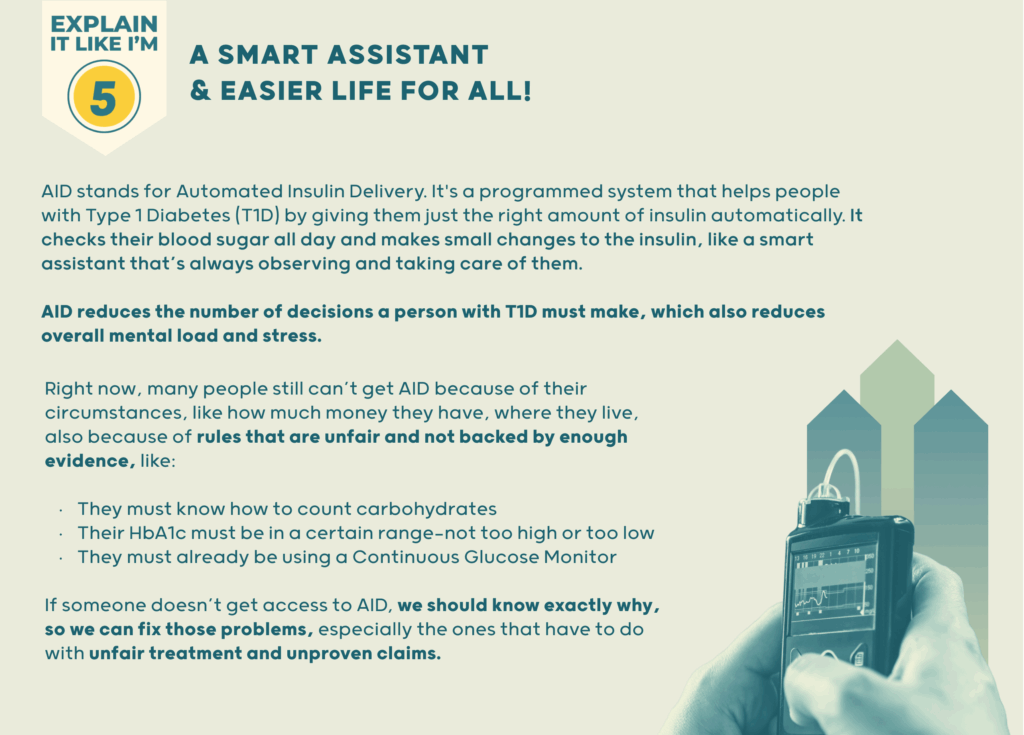Automation for All: Ending the Inequality in Diabetes Care
D-coding the Article- : A Call-to-Action to Eliminate Barriers to Accessing Automated Insulin Delivery Systems for People with Type 1 Diabetes
Published Date:
16 January 2024
Published By:
Banshi Saboo, Satish Garg, Richard M. Bergenstal, Antonio Ceriello, Pratik Choudhary, Martin De Bock, Nancy Elbarbary, GregoryForlenza, Ana Maria Gomez, BrunoGrassi Corrales, Julia Mader, David O’Neal and Peter Schwarz.
Approved By:
Dr. Banshi Saboo
Decoded By:
Asra H. Ahmed
MBA, PGCE in Assessment Learning disability, Diabesties Foundation.
10 mins to read
- The T1D Takeaway
- This article is a powerful reminder that everyone with Type 1 Diabetes—and others who rely on insulin—deserve the gold standard classified as AID systems.
- We deserve the right to choose whether AID is right for you—without judgment. Advocating for better care means we must ask questions and speak up if we are denied access unfairly
- As healthcare professionals empathize with us, we know we are not alone—and change will happen.
Word Wizard
- Research shows that AID systems can greatly improve blood sugar control, reduce lows, and make life with diabetes less stressful.
- Many people are still denied accessbecause of cost, insurance hurdles, or unfair assumptions about who can use these devices.
- Health experts and international guidelines say that AID systems should be the first choicefor people with T1D. But for that to happen, the entire healthcare system—policymakers, doctors, and insurers—must work together to remove the roadblocks.
- CGM are not enough Automated Insulin Delivery (AID) systems offer superior glycemic control compared to CGM alone or CGM + MDI (multiple daily injections).
- AID users consistently achieve:
- Time in Range (TIR) of 65–80% (goal: >70%)
- Lower HbA1c (1.5–2.4% improvement over CGM+MDI)
- Very low rates of hypoglycemia
- The “must be tech-savvy” idea is outdated and biased. Gatekeeping accessibility is not the role of HCP, offer choice to the person living with diabetes.
Summary Snap
Shots
Automated Insulin Delivery (AID) systems are proven to give better blood sugar control, reduce diabetes burden, and should be the standard of care for all with insulin-dependent diabetes. Despite strong global support, many still face unfair barriers to access—this commentary calls on healthcare systems, providers, and payers to ensure everyone gets a fair chance to use AID.
Prime Insight
AID Systems Are the Gold Standard. Automated Insulin Delivery (AID) systems offer superior glycemic control compared to CGM alone or CGM + MDI (multiple daily injections).
The DIAMOND trial showed only 18% of people on CGM+MDI reached HbA1c <7%. Their time Above Range (TAR) remains high—over 44%. High Blood Sugar Still Hurts leads to serious long-term problems—not just for the body, but also for the brain, especially in children.
AID provides better blood sugars, less stress—so “Why Isn’t This the Standard for everyone with Diabetes?"

The tech is ready, the data is clear, diabetes care has evolved, yet access has not kept pace.
AID Reduces burden and the mental load of diabetes for both people living with T1D and their caregivers owing to more automation, fewer decisions, and more peace of mind. However, many still can’t access AID owing to Cost, Provider gatekeeping,
Insurance rules keep AID out of reach for many.
Further common barriers are:
- Must know carb counting
- HbA1c too high or too low
- Must already be on CGM
These restrictions are not backed by evidence.
Restricted access marginalizes better management of millions.
Equity cannot happen if decisions about who gets AID are sometimes influenced by unconscious racial and socioeconomic bias. A unified voice is being raised for a strong, clear call to action by all stakeholders: government bodies, people living with diabetes and health care professionals.
If AID is not provided, the reasons should be documented to identify and eliminate barriers such as cost and access. Through this paper the call is endorsed globally backed by leading diabetes expert worldwide and organizations like: Breakthrough T1D (JDRF), ISPAD, ATTD, Diabetes India, and others
- A Deeper Dive
- The Sources Voice
“The standard of care for glycemic management in youth and adults with T1D is an AID system.”
- Curiosities Clarified
No. CGM helps, but CGM + MDI alone isn’t enough for many people to meet targets like Time in Range >70% or HbA1c <7%.
It shouldn’t be. Countries like the UK now fund AID systems for all PwT1D—proving it’s possible with the right policies.
Yes. Groups like the ADA, ISPAD, and NICE now endorse AID as the preferred option for managing T1D.
